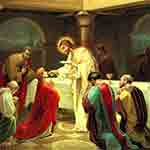
Cardinal Sarah, prefect of the Vatican Congregation for Divine Worship, recently wrote that he sees receiving communion kneeling and on the tongue as the much more suitable approach. In strong words, he wrote:
We can understand how the most insidious diabolical attack consists in trying to extinguish faith in the Eucharist, sowing errors and favoring an unsuitable manner of receiving it. Truly the war between Michael and his Angels on one side, and Lucifer on the other, continues in the heart of the faithful: Satan’s target is the Sacrifice of the Mass and the Real Presence of Jesus in the consecrated host.
Why do we insist on communicating standing in the hand? Why this attitude of lack of submission to the signs of God?
The debate about this gets surprisingly heated. Some really do see this as the battle line drawn between Satan and Archangel Michael.
The mistreatment of some of the historical documents is reminiscent of the way that some people treat the scriptures, often anachronistically.
When Leo the Great (c. 400 – 10 November 461), in commenting on John 6, claims that “One receives in the mouth what one believes by faith”, this is not some argument that in the fifth century receiving communion on the tongue rather than in the hand is “a well-established fact“. This is simply Leo expressing what we all know – communion, the Bread of Life, is received by eating: in the mouth.
As for what is made of the encouragement by Basil of Caesarea (c. 330 – January 1 or 2, 379) to receive communion daily, and “in times of persecution to be compelled to take the communion in his own hand without the presence of a priest or minister” – this is stretched even further! Basil is clearly writing of people not easily able to be part of a Eucharist service and so they have, at home, bread that has been consecrated. This is the reference to persecution; this is the reference to not having the presence of a priest – Basil is talking about not moving out and about so easily (and hence to church for the Eucharist) because of persecution, and so taking communion by oneself (λαμβάνειν τῇ ἰδίᾳ χειρί – by your own hand – rather than from another) is understandable.
But this is stretched to breaking with claims that “St. Basil the Great considered Communion in the hand so irregular that he did not hesitate to consider it a grave fault.” (And see, similarly, here, here, here, and so on).
To add an Anglican perspective, the communion rite in the 1549 BCP concludes:
And although it bee redde in aunciente writers, that the people many yeares past received at the priestes handes the Sacrament of the body of Christ in theyr owne handes, and no commaundement of Christ to the contrary: Yet forasmuche as they many tymes conveyghed the same secretelye awaye, kept it with them, and diversly abused it to supersticion and wickednes: lest any suche thynge hereafter should be attempted, and that an uniformitie might be used, throughoute the whole Realme: it is thought convenient the people commonly receive the Sacrament of Christes body, in their mouthes, at the Priestes hande.
From this one can conclude that receiving communion in the hand was a reality in 16th-century England.
If you appreciated this post, consider liking the liturgy facebook page, using the RSS feed, and/or signing up for a not-very-often email, …




It’s interesting to me that someone who has achieved the high office of Cardinal, isn’t educated enough in the Old Testament that he continues with the less learned to confuse Lucifer and ha Satan as being one and the same heavenlt creatures.
Does he really believe that the being in the story of Job at some “time” in eternity also led 1/3 of the hosts of Heaven in rebellion?
I know that it can be confusing, I just expect better of those in high places.
Dear Bosco, as you may be aware, we still have a few people at SMAA receiving the consecrated bread on the tongue. One recognises this tradition is still preferred by some ex-Roman Catholcs. I prefer to kneel to receive the Sacrament, but old age does not always allow for this act of homage. I guess one learns to live with both old and new ways – as long as these acts are done with reverence
Thanks, Fr Ron. As you say, standing or kneeling, one can receive with reverence. NZ’s RC GIRM has “standing is the most common posture for receiving Holy Communion, though individual members of the faithful may choose to receive Communion while kneeling” (160). Similarly, one can reive the Sacrament reverently on the tongue or in the hand, “the choice lying with the communicant” (161). The 5th-century St Cyril gives good, reverent instructions: “When you approach, do not extend your hands with palms upward and fingers apart, but make your left hand a throne for your right hand, since the latter is to receive the King.” Blessings.
We are Easter people. We have been buried with Christ in the tomb in our baptism and have been raised with him. We no longer lie motionless in the tomb. We stand with the One who has raised us up. And we don’t stand still. We are a pilgrim people, sustained in our pilgrimmage with the Bread of Life and the Cup of Salvation. Standing, then, is surely the appropriate posture for receiving the Blessed Sacrament. And it feels right to stand in solidarity with others rather than kneeling in that introverted way which focusses the gaze downward and inward. If we are concerned about being reverent, it seems to me that nothing could be more irreverent that the practice I have experienced several times (even in our cathedral at an episcopal ordination) when people were instructed to “sit or kneel” after the Benedictus for the institution narrative during the Great Thanksgiving. Extraordinary! Maybe we could also get rid of those fences called altar rails to facilitate a less regimented sense of gathering and promote genuine communion.
Thanks, David. Your point echoes those gathered at the Council of Nicaea who were surprised (shocked?) to hear some people knelt to pray on Sundays and in the Great 50 days of the Easter Season and so made a canon that, at those times, prayer was to be done standing. I was surprised (shocked?) to see altar rails (fences) with the wonderful new altar in Ely Cathedral. Blessings.